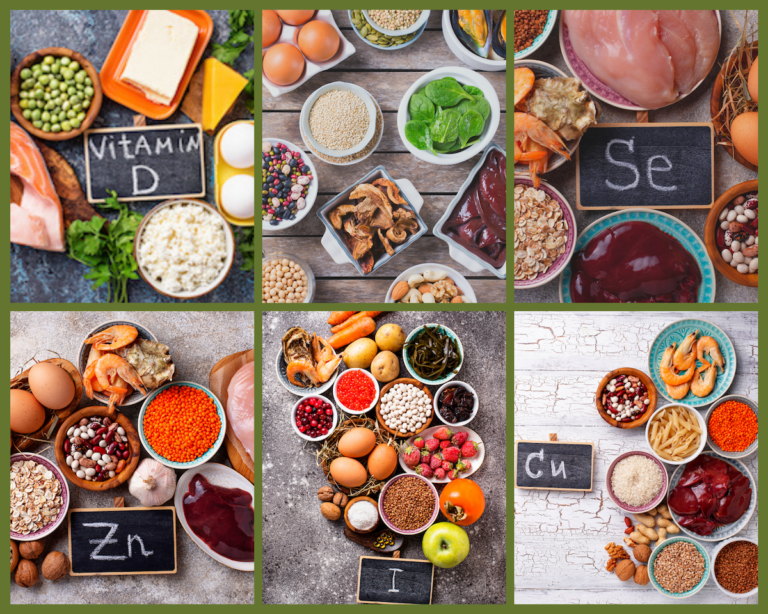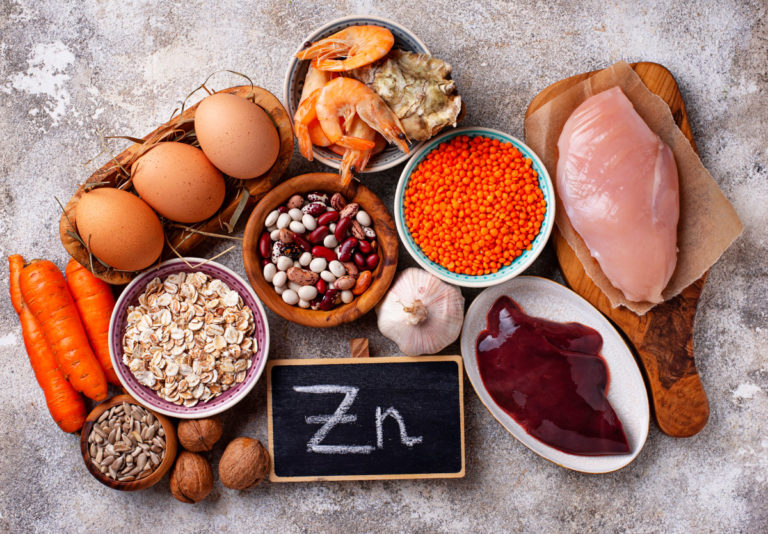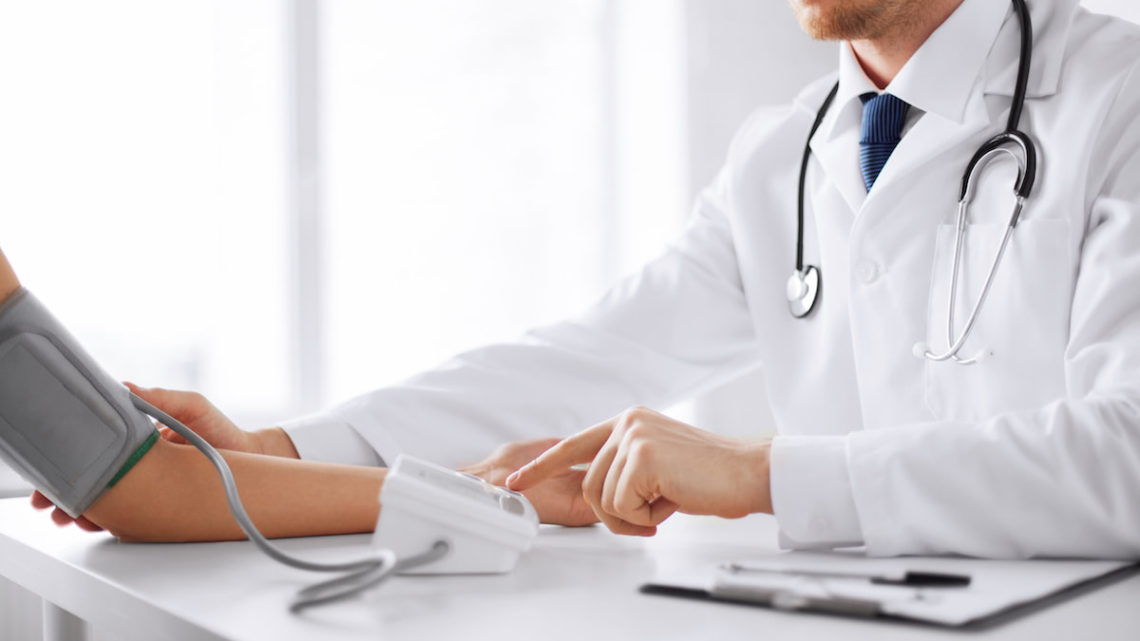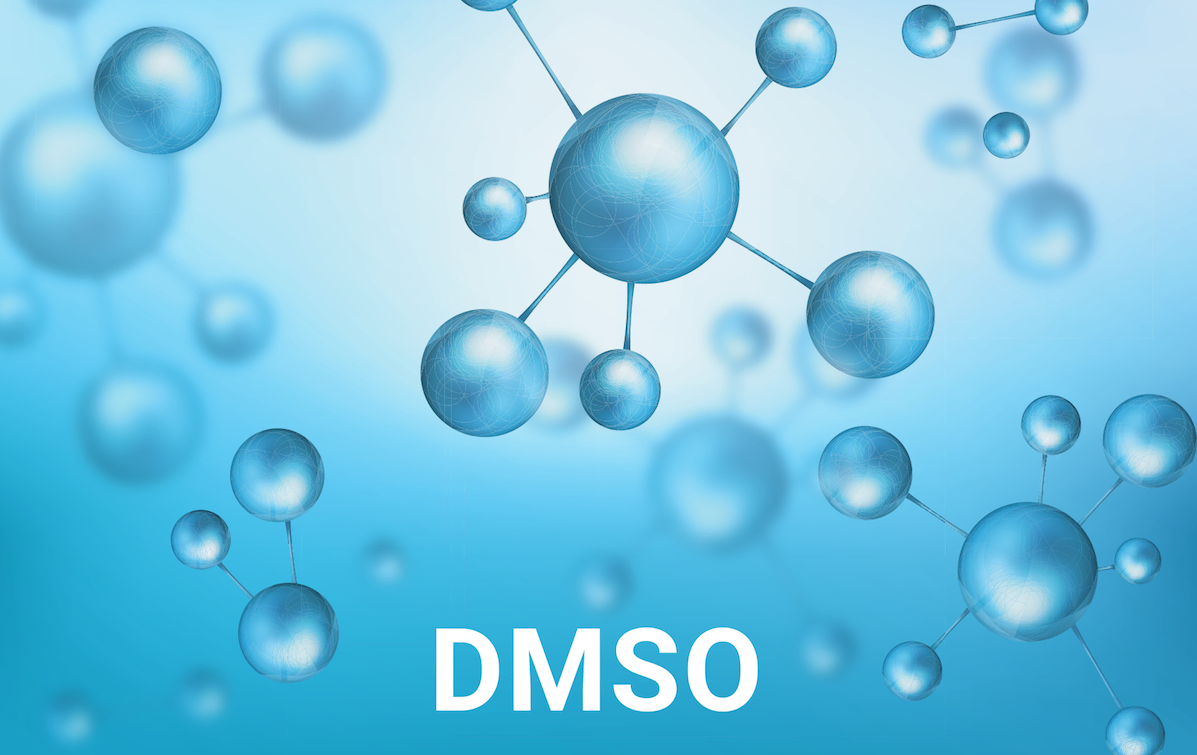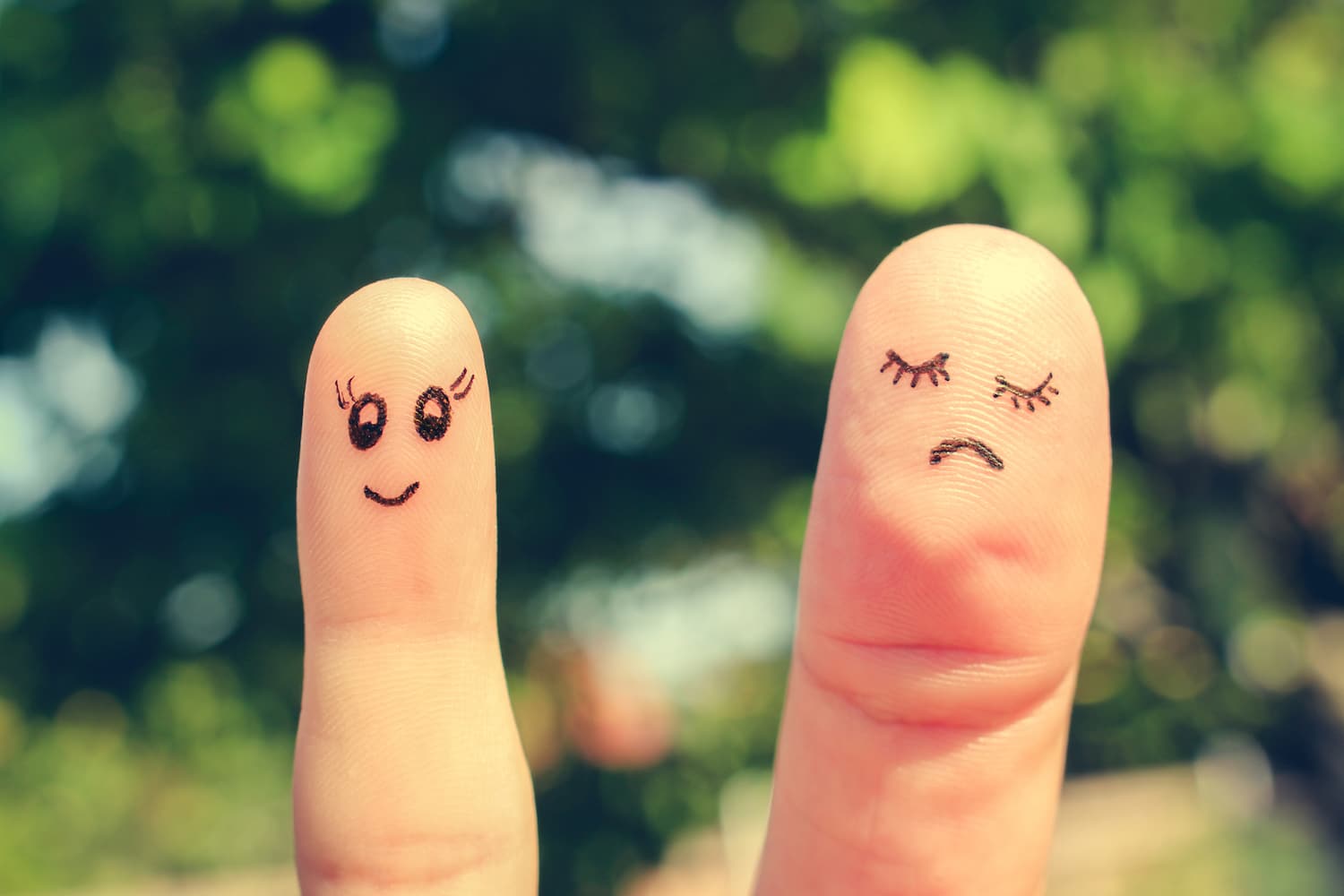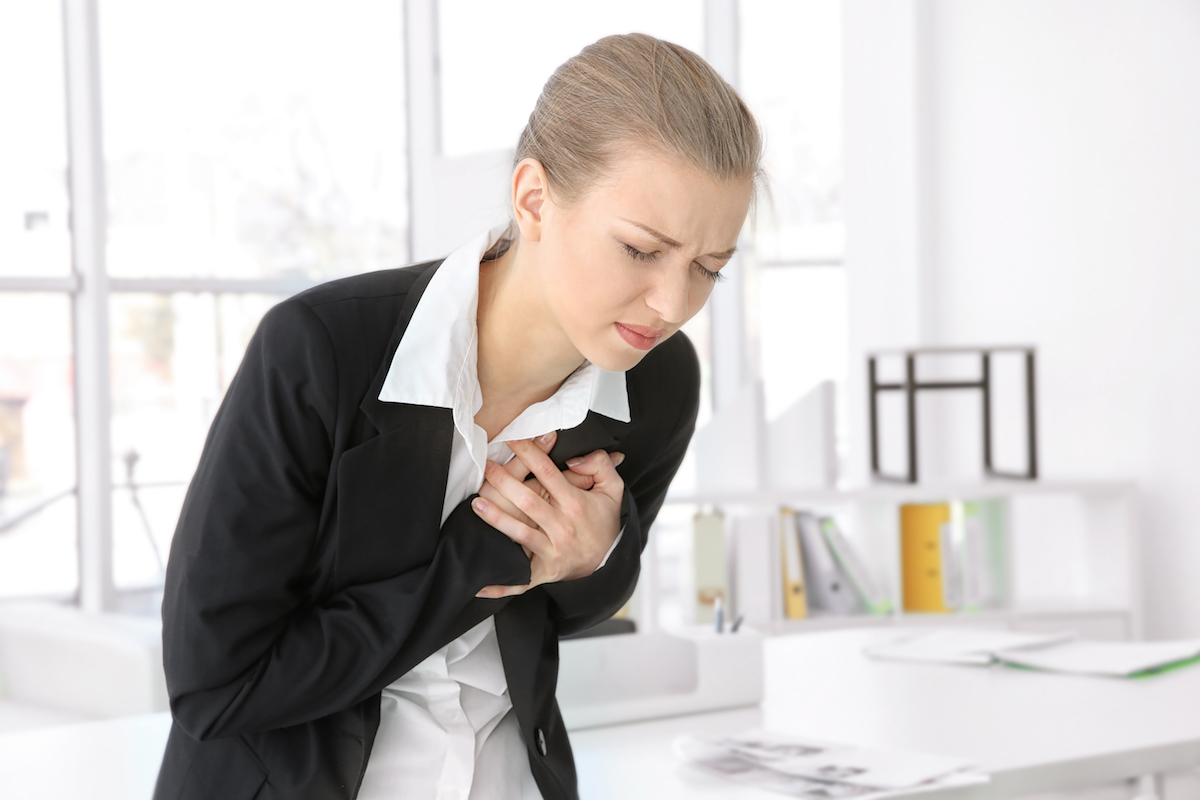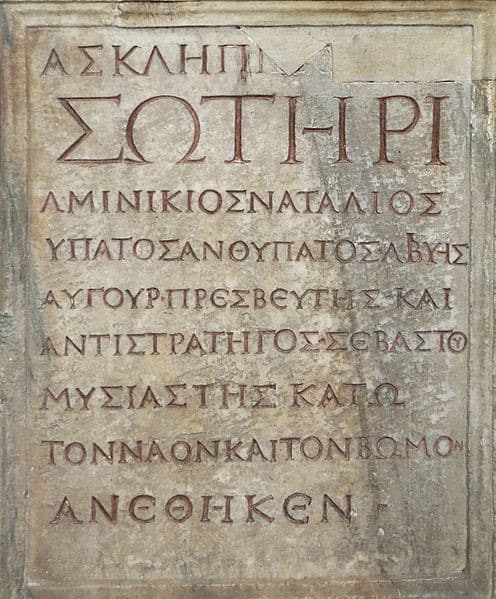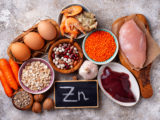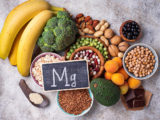Updated on 26. February 2022 from ÁYIO-Q Redaktion
Reading time: approx. 15 minutes
An unknown risk – What to do about low blood pressure?
Too low blood pressure can have various causes. Depending on the cause, low blood pressure (hypotension) can occur either permanently or in certain situations: when standing for a very long time or after turning (orthostatic dysregulation), after eating (postprandial hypotension) or during pregnancy.
Would you like to find out the reasons for your low blood pressure? Then you have indeed come to the right page. Read in this article about the most important causes and therapies for low blood pressure and the associated circulatory problems.
- Description & Boundary markers
- Signs & Symptoms
- Causes
- Diagnose
- Conventional treatmentg
- Risk factors
- Natural & alternative therapy options
What is low blood pressure and the cut-off points ?
The term blood pressure describes the pressure in the large arteries. On the other hand, blood pressure is influenced by the pumping capacity of the heart, i.e. the amount of blood transported into the circulation per heartbeat.
According to the WHO (World Health Organisation), blood pressure should preferably be below 120 to 80 mmHg. When the systolic value falls below 110 (men) or 100 (women) and the diastolic value falls below 60, doctors speak of a drop in blood pressure (arterial hypotension). The table shows how deviations from the optimal value are analysed:
Blood pressure values
| systolic blood pressure value | diastolic blood pressure value | |
| Low blood pressure | under 100 /110* mmHg | under 60 mmHg |
| Normal blood pressure | 100/110* – 129 mmHg | 60 – 84 mmHg |
| High normal blood pressure | 130 – 139 mmHg | 85 – 89 mmHg |
| High blood pressure | from 140 mmHg | from 90 mmHg |
* Values below 110/60 are considered low blood pressure in men, below 100/60 in women.
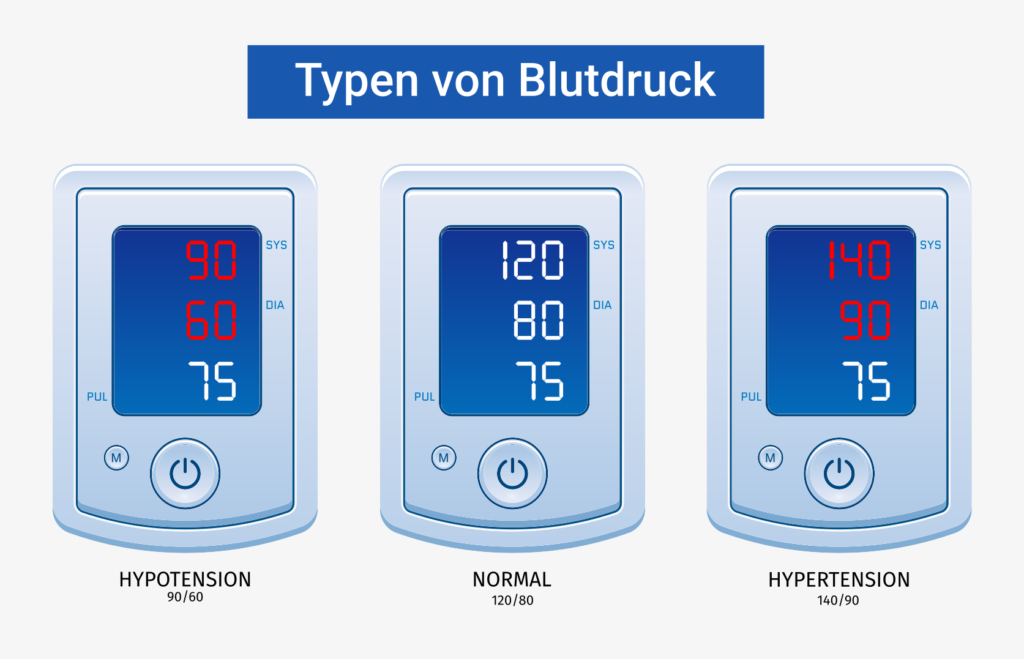
Low blood pressure is very rarely a threat. Only if the values drop too much can low blood pressure become a concern – there is a risk of fainting. Occasionally, arterial hypotension is a sign of a potentially serious disease of a body organ.
Symptoms of low blood pressure (hypotension)
Low blood pressure does not trigger symptoms all the time. However, if low blood pressure triggers symptoms like the following and they occur frequently or very suddenly, the cause should be clarified by a doctor:
- Palpitations: Low blood pressure is often accompanied by a rapid heartbeat (pulse). This is because the body wants to counteract the reduced blood flow – and it does this by getting the understanding nervous system to make the heart beat faster.
- Dizziness: Low blood pressure also indicates insufficient blood flow to the brain. The blood swims in the legs and the body needs a minute to get the blood pressure back under control.
- Headache: Low blood pressure is often accompanied by (stabbing, vibrating) migraine attacks. The reason: the blood flow in the head is reduced. In this case, it can help to eat something and thus increase the amount of blood flowing. A walk is also good, because the fresh air improves the oxygen supply to the mind and stimulates the blood flow.
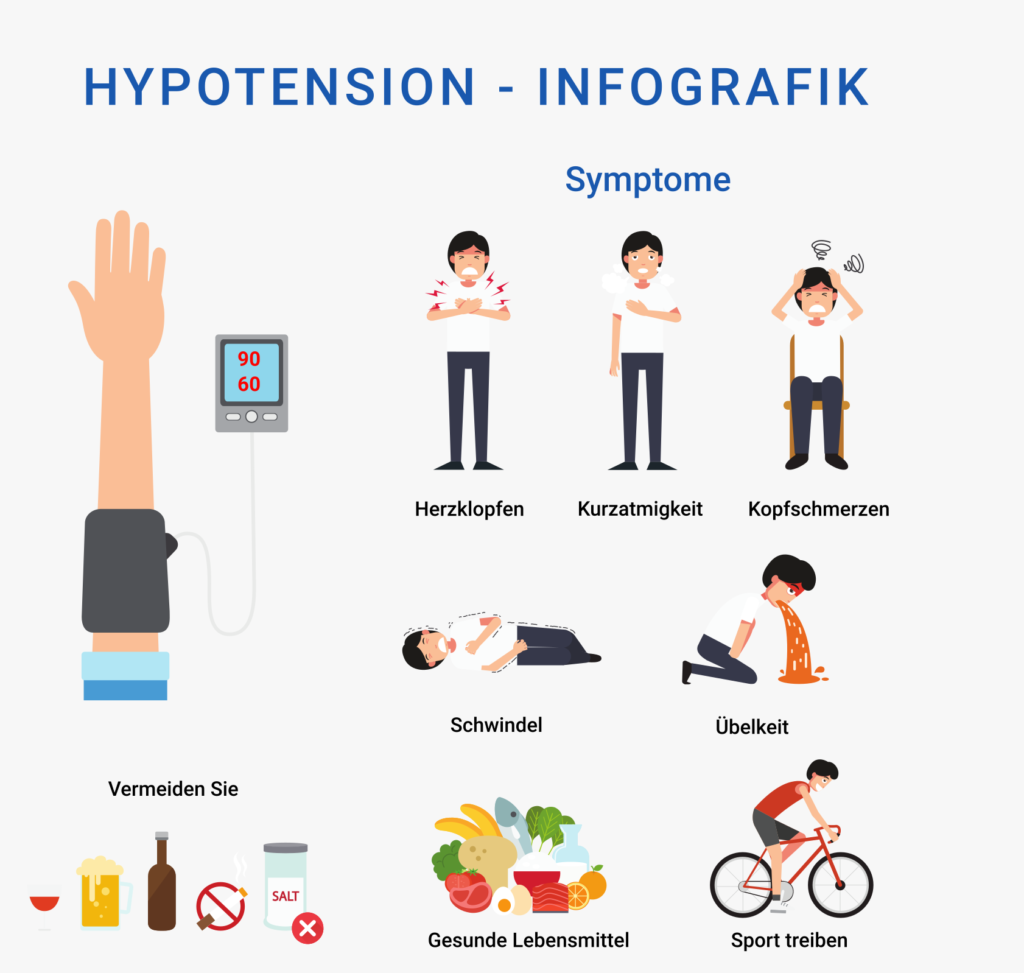
Possible causes of low blood pressure (hypotension)
Blood pressure varies from person to person. A drop of only 20 mmHg can trigger problems in some people. There are different types and also causes of reduced high blood pressure.
Severe hypotension can be caused by sudden blood loss (shock), severe infection, cardiovascular disease or severe allergy (anaphylaxis).
Orthostatic hypotension is caused by a sudden change in body position. This usually happens when you go from lying down to standing up. This type of drop in blood pressure usually only lasts for a few seconds or minutes. If this type of drop in blood pressure occurs after eating, it is called postprandial orthostatic hypotension. This type of hypotension is most common in older adults, people with high blood pressure and people with Parkinson’s disease.
Neurally mediated hypotension (NMH) usually affects young people and children. It can occur when a person has been standing for a very long time. Young people usually grow out of this form of hypotension.
Certain medicines and substances can cause low blood pressure, including:
- Alcohol
- Medicines for Anxiety
- Certain antidepressants
- Diuretics
- Heart medicines, including those used to treat high blood pressure and coronary heart disease.
- Medicines used for surgical procedures
- Painkillers
Several other causes of reduced high blood pressure are:
- Nerve damage caused by Diabetes
- Changes in heart rhythm (arrhythmias)
- Insufficient fluid intake due to alcohol (dehydration)
- Heart failure
Medical diagnosis of low blood pressure
To detect hypotension, the doctor first measures the blood pressure, possibly repeatedly. A good way to objectively examine circulatory function is the Schellong test. In this test, the person first rests or sits down for some time before briskly standing up and remaining standing. At regular intervals, usually every 30 or 60 seconds, the doctor measures the pulse rate and the blood pressure. He can also record the electrical work of the heart (ECG). In this way, the doctor can quickly determine whether orthostatic hypotension is present.
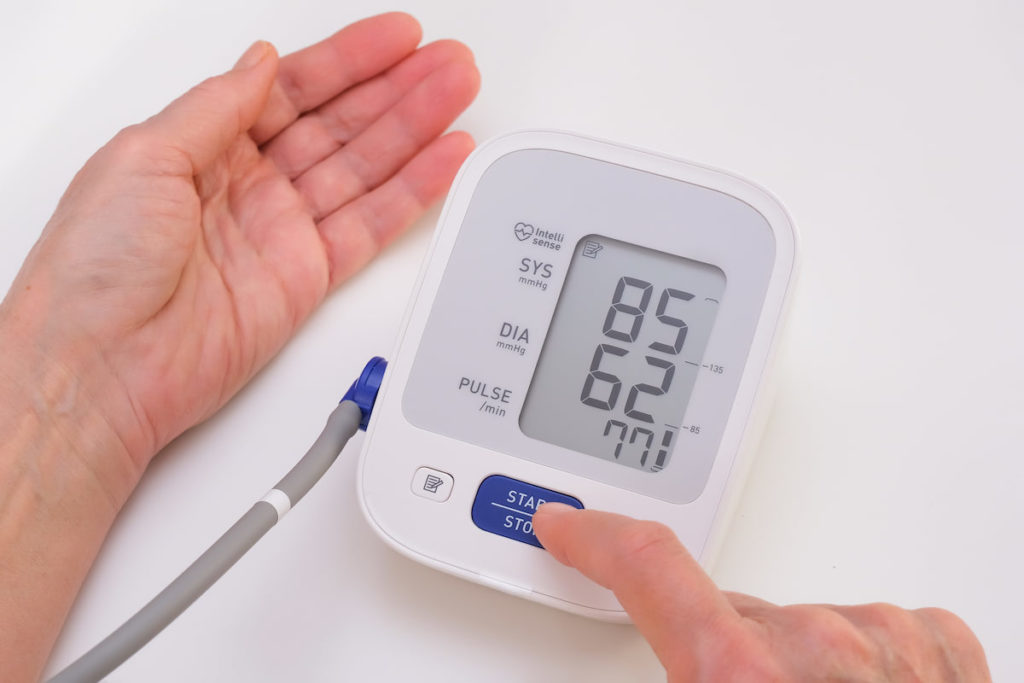
Another objective, but also much more elaborate approach is the examination on the so-called tilt table in the health facility. On this tilt table, the client can be fixed with restraining straps, and the table can also be raised by 60 steps. First, the person is put on a high blood pressure cuff and electrodes for continuous measurement of the heart (ECG display). Then the patient lies quietly on the table for about 10 minutes while the blood pressure and heart currents are checked. The couch is set up and the measurement continues. The tilt couch is mainly used to clarify states of collapse (syncope).
If the blood pressure is very low or the symptom has only recently appeared, the doctor looks for the cause. A first quick method is ultrasound and blood tests. These provide information about thyroid, parathyroid, vascular and heart diseases.
The person is fitted with a blood pressure cuff and electrodes to measure the heart rate continuously (ECGscreen). The patient lies still on the table for about 10 minutes while the blood pressure and heart flows are checked.
Conventional therapy for low blood pressure
Medication is usually not needed. Low blood pressure is only treated when it actually poses a threat or distress to those affected because low blood pressure is generally not dangerous. Nevertheless, before treatment, an underlying disease must be ruled out and, if necessary, treated. If the above simple steps are not enough, the physician has various agents available to treat hypotension. On the one hand, there are the so-called Sympathomimetics. They act on both the heart and the blood vessels, increasing the pressure in the arteries and veins. Possible adverse effects of these drugs include heart palpitations and malaise. For orthostatic hypotension, the Alpha Adrenoreceptor Agonists another option. These are generally only used in severe cases.
Risk factors for low blood pressure
Numerous risk aspects favour low blood pressure:
Physical risk aspects cannot be influenced. Decreased blood pressure often affects tall, slim people, young people in a growth spurt, pregnant women and older people.
Behavioural risk aspects can be influenced by health-conscious behaviour. Such risk factors are lack of exercise, cigarette smoking and also extreme alcohol consumption.
Treatable risk issues are Eating disorders which are mainly associated with being underweight.
12 tips for self-help with natural remedies and home remedies
The simple procedures listed below can usually help people with low blood pressure:
1. Daily exercise
For people with reduced hypertension, it is important to exercise daily. This does not necessarily have to involve exercise. You can simply leave the car at home more often and ride your bike instead. Or get off the bus one stop earlier and walk the rest of the way. Such behaviours benefit people with low blood pressure. They do not change high blood pressure, but they usually improve circulation problems and dizziness.
2. Gradually get up
If you are struggling with orthostatic signs and symptoms when you get up early in the morning, you need to sit up slowly from an existing position. You can have a two-minute sitting phase between resting and getting up. Exercises that improve circulation are also useful: you can boost blood return from your leg capillaries while lying down or resting by stretching your feet and pulling them towards you. Cycling in the air while lying in bed is also a good exercise. Some people have much less trouble if they raise the headboard 20 degrees instead of lying flat.
3. Alternate hot and cold showers
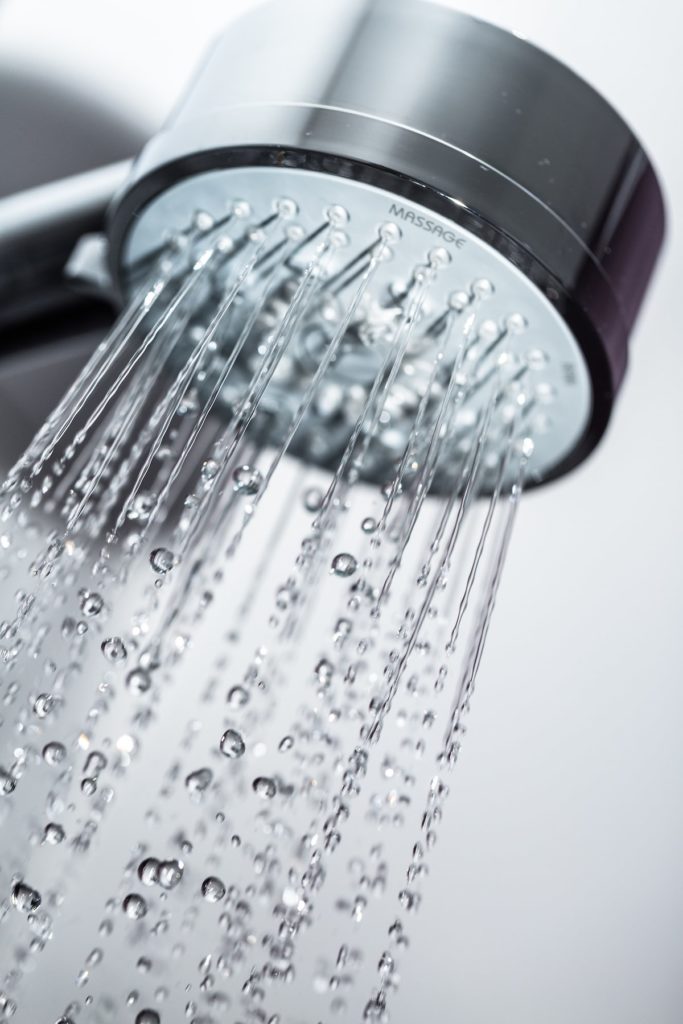
Alternating between warm and cold temperatures can also promote circulation. Alternating warm showers is a good option. If it is too much effort, it is sufficient to shower the legs up to the buttocks with both warm and cold water at the same time.
Caution: If you have blood vessels or a heart condition, you should ask your doctor beforehand if there is anything that speaks against this type of therapy!
4. Wear compression stockings if necessary
People with varicose veins should wear compression stockings to prevent blood from pooling in the legs.
5. Make sure you have a sufficient salt intake
People with reduced hypertension should pay attention to adequate salt intake in their diet. They should not consume more than 5 grams of salt per day.
6. Drink sufficient amounts of fluids
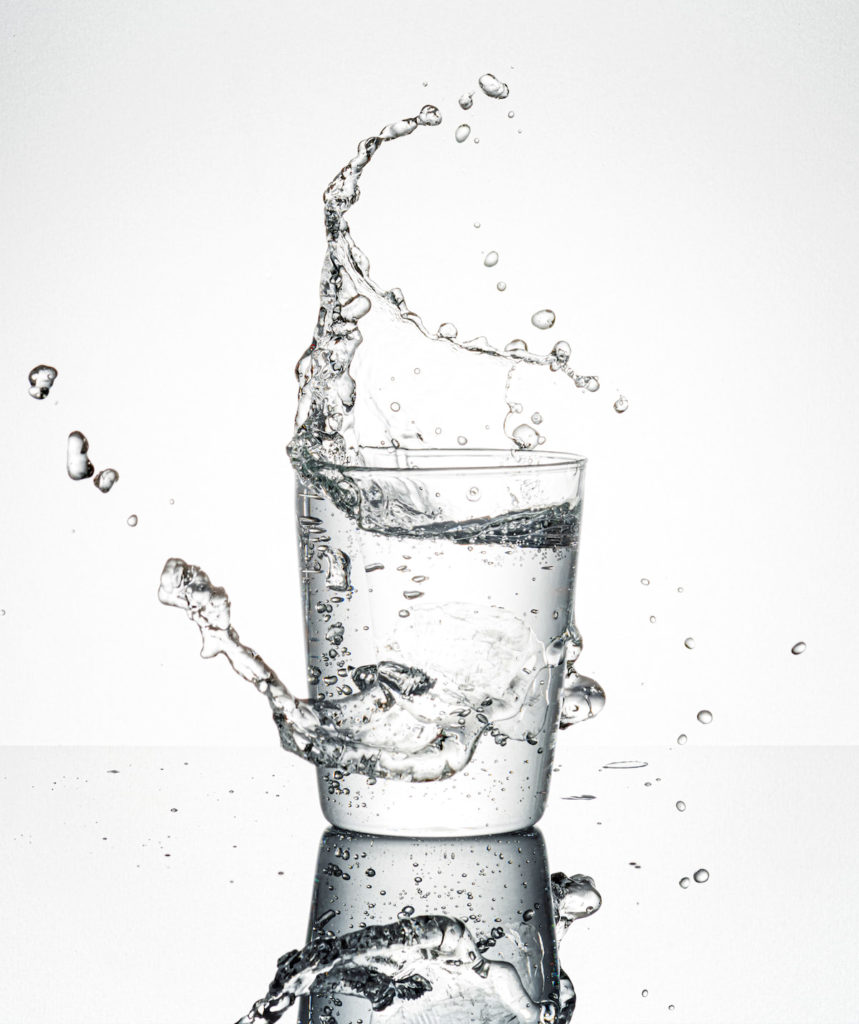
Drinking enough fluids is important to relieve the signs and symptoms. A balanced and healthy person should drink about 2 litres of fluid per day. A cup of black tea or coffee can also be helpful.
Important: People who take diuretics, usually found in over-the-counter “vein solutions”, or who have heart or kidney disease, should talk to their doctor about what fluid intake is appropriate for them.
7. Move whilst standing
Especially when standing for long periods of time, it can be helpful to regularly wiggle your toes. If you have problems with blood flow, squat or cross your legs. If that doesn’t help quickly, relax or sit down to be on the risk-free side.
8. Foods that are ideal for raising low blood pressure
- Salt is likely to raise blood pressure because salt binds water in the body, causing blood pressure to rise. Most people have particularly low blood pressure in the morning. In this case, it is advisable to eat something salty. This could be a pretzel, for example. The effect wears off quickly and the feeling of well-being returns.
However, people who suffer from kidney or heart problems should avoid a high-salt diet plan. Since the body often retains water and sodium (table salt) in kidney disease, a high-salt diet can trigger high blood pressure. For this reason, it must be avoided in these cases.
- Eat smaller portions throughout the day: If you eat too large meals, your gastrointestinal system has a lot to do. To do this, the gastrointestinal organs need blood, which is then “missing” elsewhere. For people who suffer from low blood pressure, this can lead to dizziness and even fainting, extreme tiredness or malaise.
- Cured meat and also smoked foods: These foods have a high salt content. The meat is rubbed with salt in advance.
- Sea fish: It consists of polyunsaturated fats
- Salty biscuits: Salty biscuits are an excellent first aid measure for the onset of dizziness caused by low blood pressure.
- Beetroot juice: 2 glasses of juice are recommended over a week.
- Licorice: Licorice root inhibits the cortisol-splitting enzyme.
- Sultanas: Raisins are good for the adrenal glands. Blood pressure remains in the normal range.
- Lemon water: Lemon water protects against dehydration. A glass of warm water with the juice of half a lemon and a pinch of salt is recommended in the early morning before breakfast.
9. Homeopathy and medicinal plants
To raise high blood pressure, there is a whole range of home remedies that can be selected independently depending on individual complaints and signs. With these gentle treatments, low high blood pressure can usually be raised again.
Homeopathy (individually or as a complex treatment)
- Gelsemium
- Sepia (ink of the squid)
- Myrtillocactus (Cactus)
- Pulsatilla (Meadowfoam)
- Calcium carbonicum (carbonic acid)
- Crataegus (Hawthorn)
Medicinal plants (individually or as a combination preparation)
- Ginseng (Panax ginseng)
- Thyme
- Mistletoe
- Camphor (Cinnamomum camphora)
- Rosemary (Rosmarinum officinalis)
- Scotch broom
- Sage
- Hawthorn (Crataegus Essences)
10. Yoga
Although yoga is not directly related to blood pressure, there are some practices that have a stimulating effect. These can minimise the discomfort of reduced blood pressure.
11. Acupuncture
Acupuncture can also help to increase blood pressure through targeted needling.
12. Reflexology of the hands
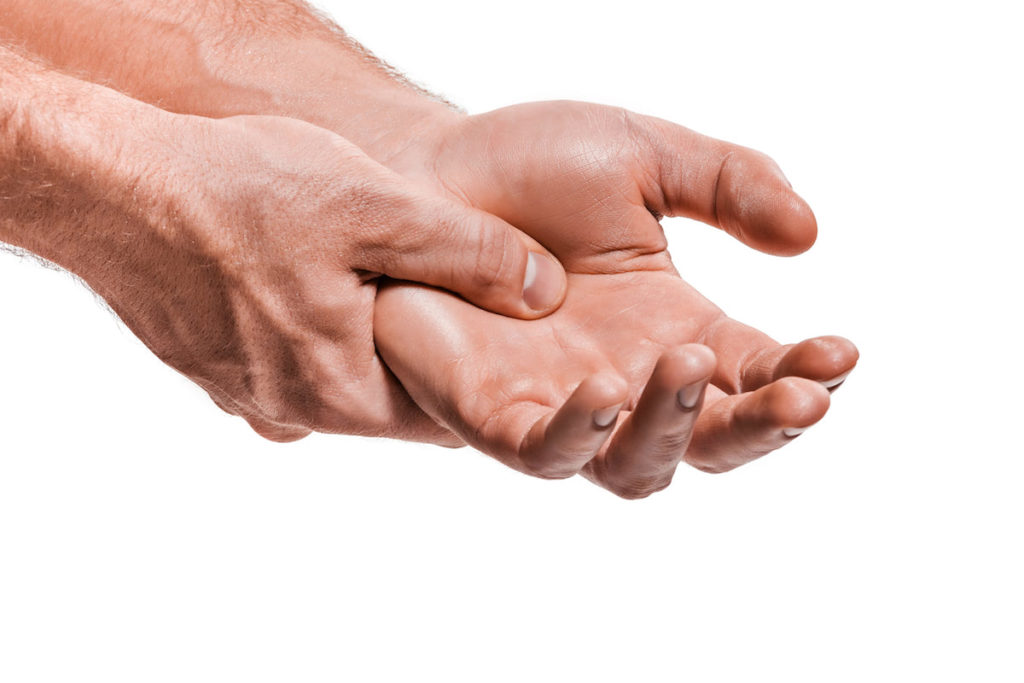
A massage of the hand reflex zones (several times a day at leisure) harmonises the blood pressure: To do this, place the thumb of the left hand on the palm of the right hand. The left index finger gently strokes the spaces between the metacarpal bones, always from the bottom upwards in the direction of the fingers. Do this 15 to 20 times for each of the three spaces. Then switch to the other hand.
Tips to finish
To ensure that every part of your body – including your brain, heart and lungs – gets enough blood and oxygen, your blood pressure usually changes throughout the day. It may drop when you suddenly get up, and it usually drops when you sleep or rest.
Hypotension, or low blood pressure, is not automatically a cause for concern. Some health and wellness conditions cause hypotension, so it’s important to talk to your doctor about any symptoms you might be experiencing.
FAQ
When should I see a doctor if I have low blood pressure?
If you regularly suffer from light-headedness, sweating or nausea after getting up or after a longer period of time, a visit to the doctor is advisable in the next few days. He can use a resting ECG, a physical examination and, if necessary, also an echocardiography to find out about a conceivable natural disease such as a reduced pumping capacity of the heart or a defect in the heart valve.
If you become unconscious, you should contact a doctor immediately.
Can I treat my low blood pressure myself?
Low blood pressure can take different forms. Before you treat your symptoms yourself with home remedies, a doctor should find out the appropriate form of hypotension. Because if the problem is called second hypotension, the lowered high blood pressure is only a sign and symptom of another disease, e.g. hypothyroidism.
Instead of using home remedies, the cause, i.e. the disease at hand, should be treated with medication. If diseases can be ruled out as the cause, there is nothing to be said against self-medication to get the body and the blood flow going.
How to deal with low blood pressure?
Occasional reduced blood pressure is probably not a cause for concern.
Tell your doctor about any relevant symptoms. Keep a record of your signs and symptoms and what you were doing when they started.
This can help your doctor diagnose the cause of your low blood pressure, especially if you have already tried to change your diet and lifestyle and your blood pressure has still not risen to a healthy and balanced level.
How to recognise the triggers of low blood pressure?
Find out how to recognise triggers and symptoms. Children and adolescents who have low blood pressure due to their posture usually experience an expansion of the blood pressure.
If you have an orthostatic blood pressure drop, you should avoid the triggers of the symptoms, e.g. excessive standing.
Emotionally upsetting scenarios can additionally lead to low blood pressure, and while these cannot always be prevented, it is helpful to know about how stress and anxiety and other factors can cause your blood pressure to drop. It is also possible that low blood pressure can lead to clinical depression.
ICD codes for this condition: I95 | I95.1 | I95.2 | I95.8 | I95.9
ICD codes are internationally valid codes for medical diagnoses. They can be found, for example, in doctors’ letters or on certificates of incapacity for work.
The web content of ÁYIO-Q.com is for your information and is in no way a substitute for personal advice or treatment by a qualified medical practitioner. The contents of ÁYIO-Q.com cannot and must not be used to make independent diagnoses or for self-medication.
Sources:
- Orthostatic Hypotension as a Risk Factor for Incident Heart Failure, auf https://www.ahajournals.org/, Zugriff 21.12.2021
- ROBERTS SR. A STUDY OF HYPOTENSION. JAMA. 1922;79(4):262–268. doi:10.1001/jama.1922.02640040008004, Zugriff 21.12.2021
- Looking for Trouble: Identifying and Treating Hypotension. P T. 2019;44(9):563-565, Zugriff 21.12.2021
- Chen Z, Zhu S, Liu M, Tang G, Zhong Z, Lu L. Effectiveness and safety of traditional Chinese medicine in the treatment of senile hypotension: A protocol for systematic review and meta-analysis. Medicine (Baltimore). 2021;100(16):e25385. doi:10.1097/MD.0000000000025385
- Alcohol Potentiates Orthostatic Hypotension, auf https://www.ahajournals.org/, accessed 21.12.2021
- Palma JA, Kaufmann H. Management of Orthostatic Hypotension. Continuum (Minneap Minn). 2020;26(1):154-177. doi:10.1212/CON.0000000000000816
